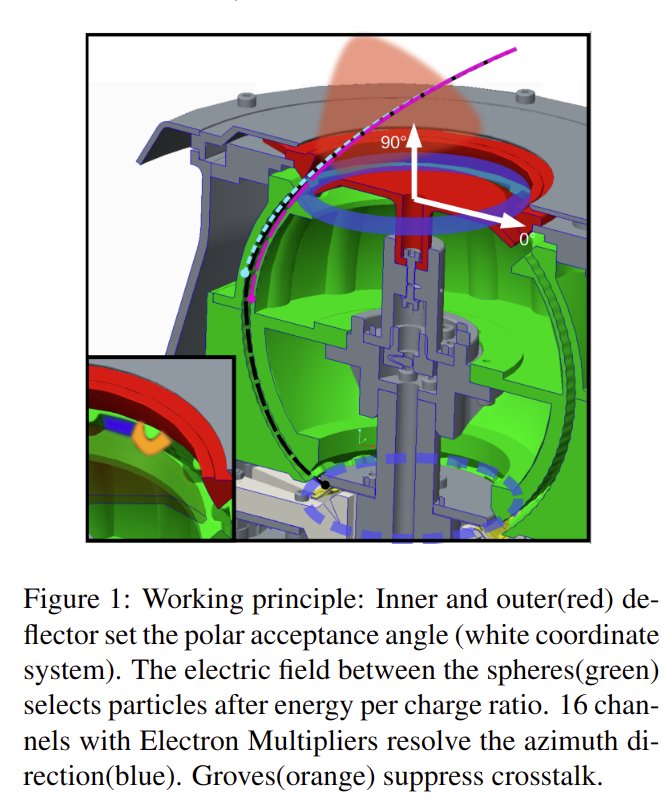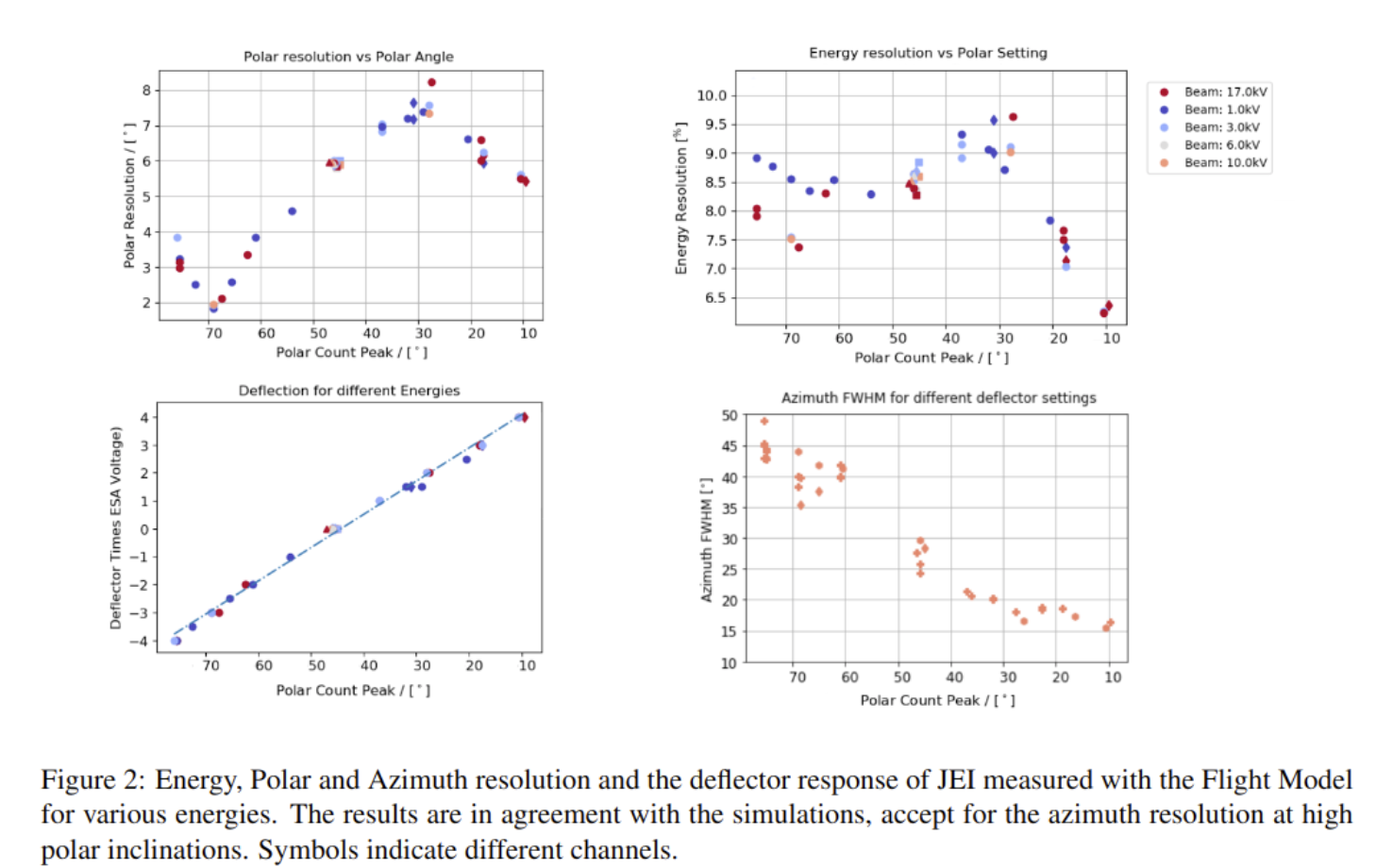EPSC Abstracts
Vol. 16, EPSC2022-1093, 2022, updated on 03 Mar 2025
https://doi.org/10.5194/epsc2022-1093
Europlanet Science Congress 2022
© Author(s) 2025. This work is distributed under the Creative Commons Attribution 4.0 License.
The Calibration results of the Flight model of the Jovian Electron and Ion spectrometer for the Jupiter Icy Moons Explorer and their link to Mercury
- Max Planck Institute for Solar System Research, Göttingen, Germany (bambach@mps.mpg.de)
Abstract
Electrostatic analyzers are key instruments for understanding magnetospheric plasma. Their measurements
also contribute to the determination of the surface and interior composition of moons and planets. They
measure properties in particle charge, energy and 3D velocity vectors of electrons and ions. Calibration of
these instruments is challenging. Ground facilities can not reproduce the electromagnetic and radiation
background of Jupiter. Also the particle flows and, their full energy- and 3D flow spectrum over the
complete field of view of a spherical analyzers can not be produced by our facilities. Instead beams
larger than the field of view of at least one detector channel reproduce step-vise parts of the parameter
spaces of the expected spectrum. By combining simulations, ground based calibration and in-flight
calibration, the reliability of the calibration can be increased. The calibration of the flight model of
the The Jupiter Electron and Ion Spectrometer (JEI) showed good agreement with the simulations, except
for a significant discrepancy in azimuth resolution and the geometric factor at high pole inclinations.
After a final upgrade of the test bench, we will allow for better comparison of results between
The Jupiter Icy Moons Explorer (JUICE) and the BepiColombo missions by cross-calibrating JEI and
the The Planetary Ion Camera (PICAM).
Electrostatic analyzers are key instruments for understanding magnetospheric plasma. Their measurements
also contribute to the determination of the surface and interior composition of moons and planets. They
measure properties in particle charge, energy and 3D velocity vectors of electrons and ions. Calibration of
these instruments is challenging. Ground facilities can not reproduce the electromagnetic and radiation
background of Jupiter. Also the particle flows and, their full energy- and 3D flow spectrum over the
complete field of view of a spherical analyzers can not be produced by our facilities. Instead beams
larger than the field of view of at least one detector channel reproduce step-vise parts of the parameter
spaces of the expected spectrum. By combining simulations, ground based calibration and in-flight
calibration, the reliability of the calibration can be increased. The calibration of the flight model of
the The Jupiter Electron and Ion Spectrometer (JEI) showed good agreement with the simulations, except
for a significant discrepancy in azimuth resolution and the geometric factor at high pole inclinations.
After a final upgrade of the test bench, we will allow for better comparison of results between
The Jupiter Icy Moons Explorer (JUICE) and the BepiColombo missions by cross-calibrating JEI and
the The Planetary Ion Camera (PICAM).

Plain Language Summary
Charged particles interact with magnetic field, planets and moons. Measuring the properties of these par-
ticles helps to understand the interaction and allows to analyze the surfaces and interiors of planets and
moons as a result of their interaction with their surrounding magnetic field. Unfortunately, calibration of
these instruments is complicated because accelerators only produce a small spectrum of the target particle
streams at once. In order to improve the results, calibration measurements on the ground are combined
with simulations and later with calibrations during the mission using known plasma, like the solar wind. The
calibration for JEI agreed with the simulations, except for high polar angles(Fig. 1.)
ticles helps to understand the interaction and allows to analyze the surfaces and interiors of planets and
moons as a result of their interaction with their surrounding magnetic field. Unfortunately, calibration of
these instruments is complicated because accelerators only produce a small spectrum of the target particle
streams at once. In order to improve the results, calibration measurements on the ground are combined
with simulations and later with calibrations during the mission using known plasma, like the solar wind. The
calibration for JEI agreed with the simulations, except for high polar angles(Fig. 1.)
This is due to the different beams used for calibration and simulation.

1 Introduction
JUICE will explore the Jovian magnetosphere and three of the four Galilean moons. After several fly-
bys of Europa and Callisto it will eventually enter orbit around Ganymede. JEI is part of The Particle Environ-
ment Package (PEP) on JUICE. JEI will measure electron and ion distributions in the range from a few eV to a few
MeV with almost full hemispheric coverage.
PICAM on BepiColombo has overlaps with JEI in its energy range from 1 eV to 3 keV. While mea-
suring ions only, PICAM has additionally a time-of-flight unit, which allows to resolve incoming particles
at a m/δm ratio of 100. There are links between Mercury and Ganymede. Besides being similar
size, they are the only known solid objects in the solar system other than Earth that have intrinsic mag-
netic fields. While the magnetic moments are similar in strength, Mercury is exposed to a supersonic plasma
of the solar wind while Ganymede is only surrounded by the subsonic plasma of Jupiter’s magnetosphere.
2. Results
For all JEI models, including the qualification model, the polar-, energy- and azimuth resolution could be
measured in agreement with the accompanying simulations and within the specifications of the original
proposal. The resolutions and deflector response are plotted in Fig. 2. Only the azimuth resolution deviates
at higher polar inclinations from the simulations. The deviation directly affects the geometric factor, which
differs over the polar inclinations in the same range.
The deviation is suspected to be reasoned by the different exposure of the sensor in the particle flow be-
tween the simulations and the beam in the test facility. Simulations and measurements with an off-center
beam are currently conducted to confirm the cause.
A slight coaxial misalignment between the inner and outer spheres could be measured due to the deviations
of the individual energy peaks of the channels.
Currently the positing system is under replacement to allow joint measurements of JEI and PICAM.
Acknowledgements
This works is supported by DLR grants 50QW1702
and 50QJ1503.
This works is supported by DLR grants 50QW1702
and 50QJ1503.
How to cite: Bambach, P., Krupp, N., Fränz, M., Roussos, E., Heumüller, P., Fischer, H., Meyer, F., and Szemerey, I.: The Calibration results of the Flight model of the Jovian Electron and Ion spectrometer for the Jupiter Icy Moons Explorer and their link to Mercury, Europlanet Science Congress 2022, Granada, Spain, 18–23 Sep 2022, EPSC2022-1093, https://doi.org/10.5194/epsc2022-1093, 2022.

